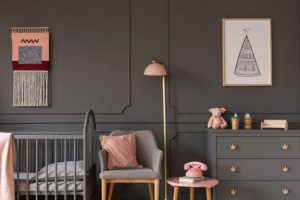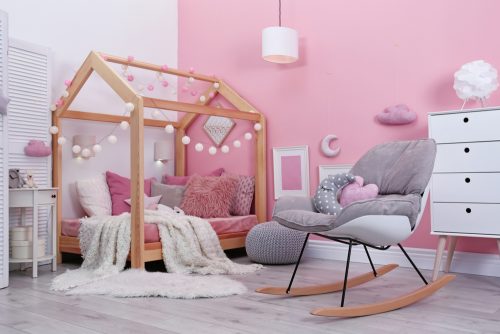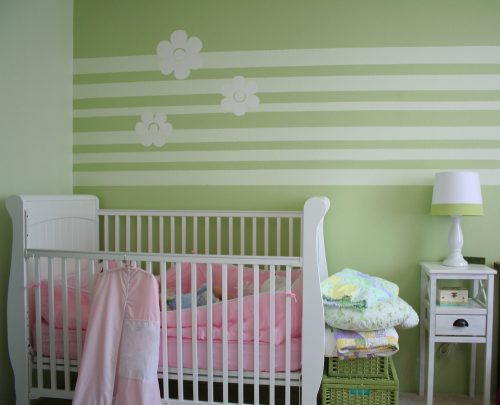4 Monochrome Baby Rooms that you'll Love

Babies need visual stimulation for proper psychological growth and development. They also need a calm, tranquil atmosphere that transmits harmony. These are just a few of the many advantages that a monochrome baby room will have for your baby.
We put a lot of tender love and care into decorating our baby’s room. It’s the space where our little one will live his or her first moments of life. It’s also the place where our baby will learn a lot of skills in addition to developing his or her personality as well. The decor elements and setting that surrounds our baby in the first months are extremely important.
Decorating trends have changed drastically in the last 5 years. One of the biggest revivals that have come back is monochrome decor. It’s tremendously popular in decoration for children.
Monochrome baby rooms have left other too colorful, or too decorated ideas behind, along with rooms that have too many rugs and tapestries. We’ll explain what monochrome decor is and we’ll show you some ideas to inspire you.
What is monochrome decor?
Just listening to the phrase, you might think that “monochrome decor” means just using one color for everything, but that’s not true. Monochrome decor consists of choosing one color and increasing or decreasing its intensity. It’s also about adding in neutral tones for texture and depth to keep the room from looking flat and dull.
You can achieve balance in a monochromatic composition by taking a pure color and using it with a complementary color that’ll create some contrast within the shades of the base. To create a successful balance, you need to know the basics of analogous colors. In decor, we can divide them into three types:
- Cool colors: all the colors that go from greens, blue-greens, blues, to lilacs.
- Warm colors: colors that go from yellows, oranges, reds to violets.
- Neutral colors: the entire range of creams, browns, grays, and greens. White, black and petrol blue are also neutral colors.

Choosing a base color and using it with neutral tones can lead to amazing results. Using this kind of color combination can make a room feel more spacious.
You can add patterns in neutral tones and use wooden furniture to add a neutral color to the room’s palette. Another idea is adding a pop of the complementary color. You can use it for pillows, rugs or other items.
1. White monochrome baby room
White can seem a little intimidating as a monochrome decor option. If you don’t use it correctly, a bedroom could end up looking dull and flat. Using it with ivory, beige shades and pale grays could create contrast and depth. If you have wooden floors or ceilings, or if you use it with a hint of charcoal gray or black, the results will be fabulous.
2. Beige monochrome baby room
Beige monochrome rooms create well-lit spaces that are warm and cozy. Rooms look lovely with a full range of beige with browns, whites, and petrol green.
3. Gray monochrome baby room
Your baby’s room could look amazing with the same colored walls, windows, and curtains. Gray is the perfect color to use different textures in fabric and paints. It goes great with whites and wood.
4. Green monochrome baby room
For children’s rooms, we suggest using a lighter gray-green shade as your base color. The color is very stimulating. It brings freshness and life into rooms, but it also provides calmness and sobriety. This color creates calm, serene settings. It especially looks wonderful with white tones and wood.

Details
Newer children’s rooms decor trends are rejecting the classic pink and blue designs. Ideally, a bedroom should be for either a boy or a girl. If you’re not completely opposed to using these colors, you can use them for adding small hints of colors to complement the room. But if you choose to use them, make sure to avoid strong tones. Especially fuschia or loud pink colors.
You’re better off going with details in blush pink or rose. Remember that less is more, which is the golden rule in decor.
Monochrome decor for a baby’s room is an idea that requires a lot of thought for the colors and materials. But it’s the right way to go because it’ll always give you clean lines and visual harmony, which are things that children and parents alike will appreciate.
Babies need visual stimulation for proper psychological growth and development. They also need a calm, tranquil atmosphere that transmits harmony. These are just a few of the many advantages that a monochrome baby room will have for your baby.
We put a lot of tender love and care into decorating our baby’s room. It’s the space where our little one will live his or her first moments of life. It’s also the place where our baby will learn a lot of skills in addition to developing his or her personality as well. The decor elements and setting that surrounds our baby in the first months are extremely important.
Decorating trends have changed drastically in the last 5 years. One of the biggest revivals that have come back is monochrome decor. It’s tremendously popular in decoration for children.
Monochrome baby rooms have left other too colorful, or too decorated ideas behind, along with rooms that have too many rugs and tapestries. We’ll explain what monochrome decor is and we’ll show you some ideas to inspire you.
What is monochrome decor?
Just listening to the phrase, you might think that “monochrome decor” means just using one color for everything, but that’s not true. Monochrome decor consists of choosing one color and increasing or decreasing its intensity. It’s also about adding in neutral tones for texture and depth to keep the room from looking flat and dull.
You can achieve balance in a monochromatic composition by taking a pure color and using it with a complementary color that’ll create some contrast within the shades of the base. To create a successful balance, you need to know the basics of analogous colors. In decor, we can divide them into three types:
- Cool colors: all the colors that go from greens, blue-greens, blues, to lilacs.
- Warm colors: colors that go from yellows, oranges, reds to violets.
- Neutral colors: the entire range of creams, browns, grays, and greens. White, black and petrol blue are also neutral colors.

Choosing a base color and using it with neutral tones can lead to amazing results. Using this kind of color combination can make a room feel more spacious.
You can add patterns in neutral tones and use wooden furniture to add a neutral color to the room’s palette. Another idea is adding a pop of the complementary color. You can use it for pillows, rugs or other items.
1. White monochrome baby room
White can seem a little intimidating as a monochrome decor option. If you don’t use it correctly, a bedroom could end up looking dull and flat. Using it with ivory, beige shades and pale grays could create contrast and depth. If you have wooden floors or ceilings, or if you use it with a hint of charcoal gray or black, the results will be fabulous.
2. Beige monochrome baby room
Beige monochrome rooms create well-lit spaces that are warm and cozy. Rooms look lovely with a full range of beige with browns, whites, and petrol green.
3. Gray monochrome baby room
Your baby’s room could look amazing with the same colored walls, windows, and curtains. Gray is the perfect color to use different textures in fabric and paints. It goes great with whites and wood.
4. Green monochrome baby room
For children’s rooms, we suggest using a lighter gray-green shade as your base color. The color is very stimulating. It brings freshness and life into rooms, but it also provides calmness and sobriety. This color creates calm, serene settings. It especially looks wonderful with white tones and wood.

Details
Newer children’s rooms decor trends are rejecting the classic pink and blue designs. Ideally, a bedroom should be for either a boy or a girl. If you’re not completely opposed to using these colors, you can use them for adding small hints of colors to complement the room. But if you choose to use them, make sure to avoid strong tones. Especially fuschia or loud pink colors.
You’re better off going with details in blush pink or rose. Remember that less is more, which is the golden rule in decor.
Monochrome decor for a baby’s room is an idea that requires a lot of thought for the colors and materials. But it’s the right way to go because it’ll always give you clean lines and visual harmony, which are things that children and parents alike will appreciate.







